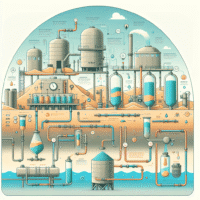High-Pressure Membrane Systems
High-Pressure Membrane Systems: The Future of Water Treatment
Introduction
As the global demand for clean, potable water escalates, high-pressure membrane systems (HPMS) have emerged as a critical technology in water treatment and desalination. These systems not only help mitigate the effects of water scarcity but also address pressing environmental regulations aimed at protecting our water resources. According to a report by the International Desalination Association, the global desalination capacity will need to double by 2030 to meet increasing water needs, compelling municipalities and industries to adopt advanced technologies like HPMS. This article delves into the principles, applications, and future of high-pressure membrane systems, providing a comprehensive overview tailored for water treatment professionals, design engineers, and municipal directors.
Understanding High-Pressure Membrane Systems
What Are High-Pressure Membrane Systems?
High-pressure membrane systems utilize semi-permeable membranes to separate contaminants from water through a process called reverse osmosis (RO) or nanofiltration (NF). By applying high pressure to overcome osmotic pressure, these systems effectively filter out salts, organic compounds, and microorganisms, producing purified effluent that meets stringent regulatory standards.
Types of High-Pressure Membrane Technologies
-
Reverse Osmosis (RO): Typically used for desalination and water purification, RO membranes allow only water molecules to pass through, blocking larger molecules and ions.
-
Nanofiltration (NF): Operating at lower pressures than RO, NF membranes are effective for removing divalent ions and larger organic molecules, making them suitable for softening hard water.
- Ultrafiltration (UF): Though technically lower in pressure than RO, UF membranes are often utilized for pre-treatment in high-pressure systems, effectively removing larger particulates, bacteria, and viruses from feed water.
The Role of High Pressure
High pressure (typically ranging from 7 to 70 bar or 100 to 1000 psi) is crucial for overcoming the natural osmotic pressure of saline solutions. The energy required for this process contributes significantly to the operational costs of high-pressure membrane systems, necessitating a focus on energy-efficient designs and alternative energy sources.
Applications of High-Pressure Membrane Systems
Municipal Water Treatment
Municipalities are increasingly turning to HPMS for reliable, high-quality drinking water, particularly in arid regions or areas with contaminated water sources. The integration of HPMS in municipal water treatment plants promotes sustainability and resilience against drought conditions.
Industrial Water Use
Industries, particularly those in food and beverage, pharmaceuticals, and oil and gas, are adopting high-pressure membrane systems for water recovery and reuse. A study from the American Water Works Association (AWWA) highlights that HPMS can reduce overall water consumption by up to 60% in manufacturing processes.
Desalination
HPMS dominate contemporary desalinization plants. Notably, facilities in the Middle East and California utilize these systems to convert seawater into drinking water. The USA’s Pacific Institute notes that advancements in HPMS technology have drastically reduced the cost of desalination, down by approximately 29% over the past decade.
Advantages of High-Pressure Membrane Systems
Efficiency and Effectiveness
Recent advancements in membrane material innovations—such as polyamide thin-film composites—have improved permeability and rejection rates, making HPMS more efficient than ever. According to the latest findings from the Water Research Foundation, modern membranes can achieve salt rejection rates of over 99%, significantly enhancing water quality.
Environmental Benefits
HPMS contribute to environmental sustainability by minimizing waste generation and supporting water recycling initiatives, thereby reducing the need for freshwater diversions. Their role in gray water reuse projects has proven especially beneficial in densely populated urban areas.
Compliance with Regulatory Standards
HPMS provide a reliable means of ensuring compliance with increasingly stringent regulations set forth by the Environmental Protection Agency (EPA) and the European Commission. They can effectively reduce contaminants to meet the Maximum Contaminant Levels (MCLs) outlined in the Safe Drinking Water Act.
Challenges and Solutions
Energy Consumption
Challenge: High-pressure membranes are energy-intensive, leading to higher operational costs.
Solution: The integration of renewable energy sources, such as solar or wind power, is gaining traction in membrane treatment facilities. Additionally, advancements in energy recovery devices (ERDs) have proven effective at reducing energy consumption by up to 60%.
Membrane Fouling
Challenge: Membrane fouling—caused by organic and inorganic contaminants—can reduce efficiency and lifespan.
Solution: Implementing pre-treatment processes, including UF and chemical dosing, can mitigate fouling. Regular maintenance schedules and advanced cleaning protocols can also support membrane longevity and performance.
Water Quality Variability
Challenge: Variability in feed water quality can impact HPMS performance and reliability.
Solution: Employing real-time monitoring systems and employing adaptive control strategies ensures optimal operation under variable conditions. These systems can adjust to changes in feed water quality, enhancing overall system resilience.
Future Trends in High-Pressure Membrane Systems
Innovation in Materials
The future of HPMS may well pivot on the development of novel membrane materials that combine higher flux rates with greater longevity. Commercialization of graphene oxide membranes has demonstrated potential for remarkable efficiencies in rejecting salts while allowing high water flow rates.
Hybrid Systems
As complexity and needs diversify, hybrid systems combining HPMS with biological treatment or advanced oxidation processes are emerging. This integration enables versatile water treatment solutions tailored to specific contaminants and circumstances.
Digital Transformation
The digital transformation of water treatment systems through IoT-enabled technologies and machine learning will facilitate predictive maintenance and proactive management, optimizing system efficiency and reliability. The implementation of smart grids in management systems can lead to enhanced integration of renewable energy sources and real-time data analysis.
Conclusion
High-pressure membrane systems play an essential role in contemporary water treatment strategies, successfully addressing the dual challenges of water scarcity and regulatory demands. As technology advances and challenges like energy consumption and membrane fouling are met with innovative solutions, HPMS will continue to evolve, paving the way for a more sustainable future in water management.
In an environment where technology is integral to sustainable water practices, understanding the principles, applications, and emerging trends of high-pressure membrane systems is crucial for professionals dedicated to water quality and resources management. The continued advancement and implementation of these systems will not only provide communities with reliable water sources but also set the groundwork for responsible and sustainable water use for generations to come.

